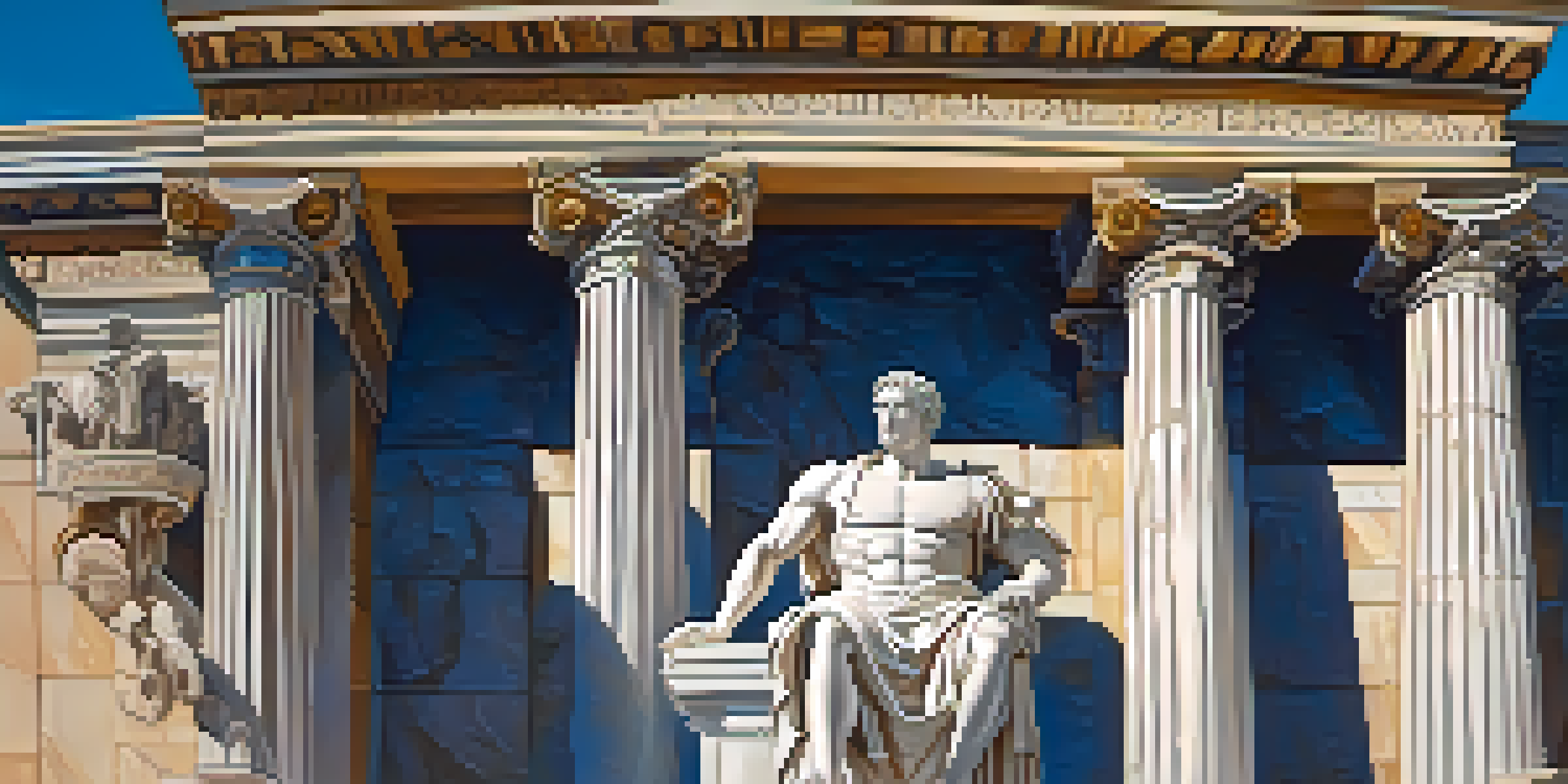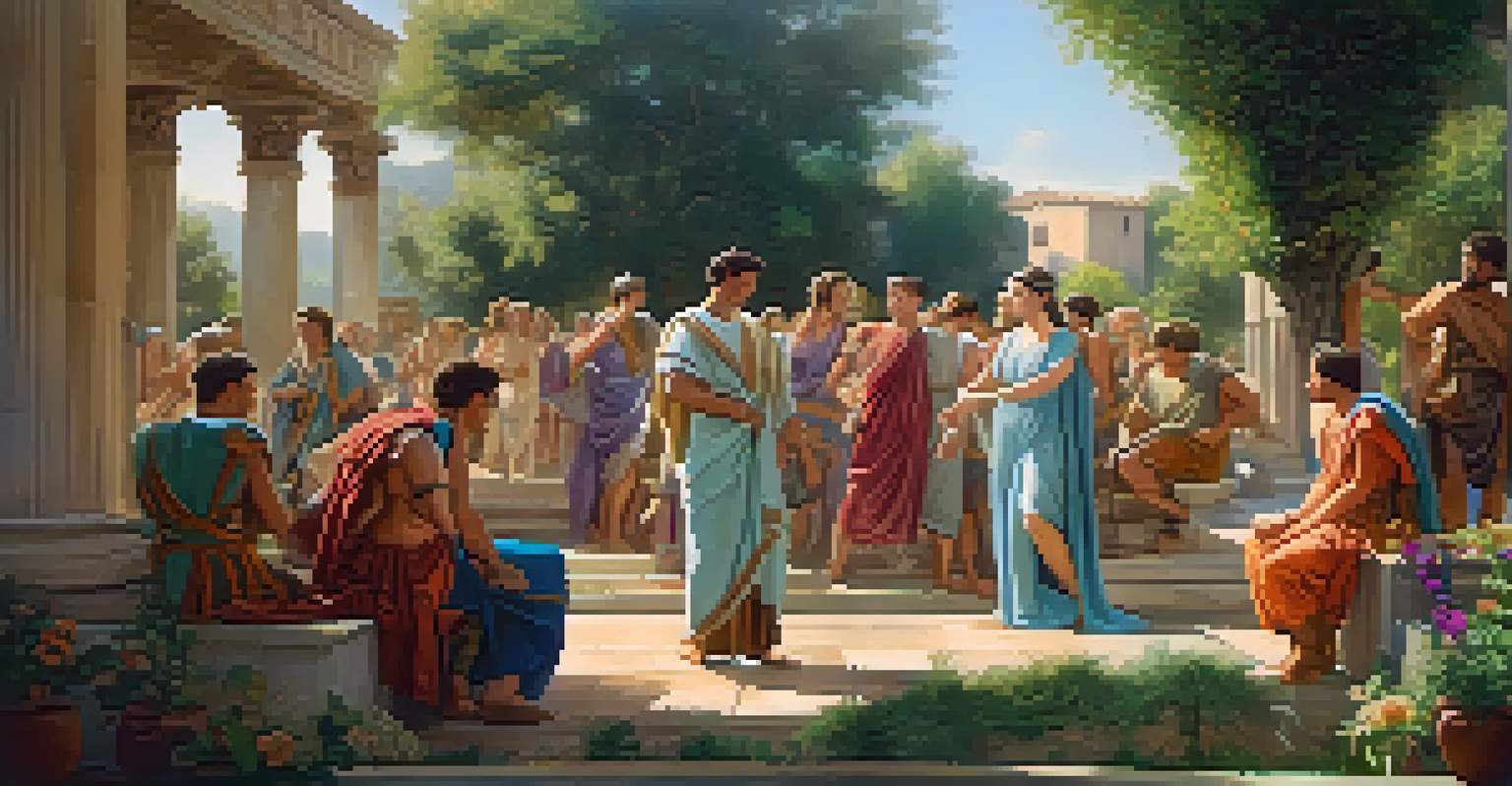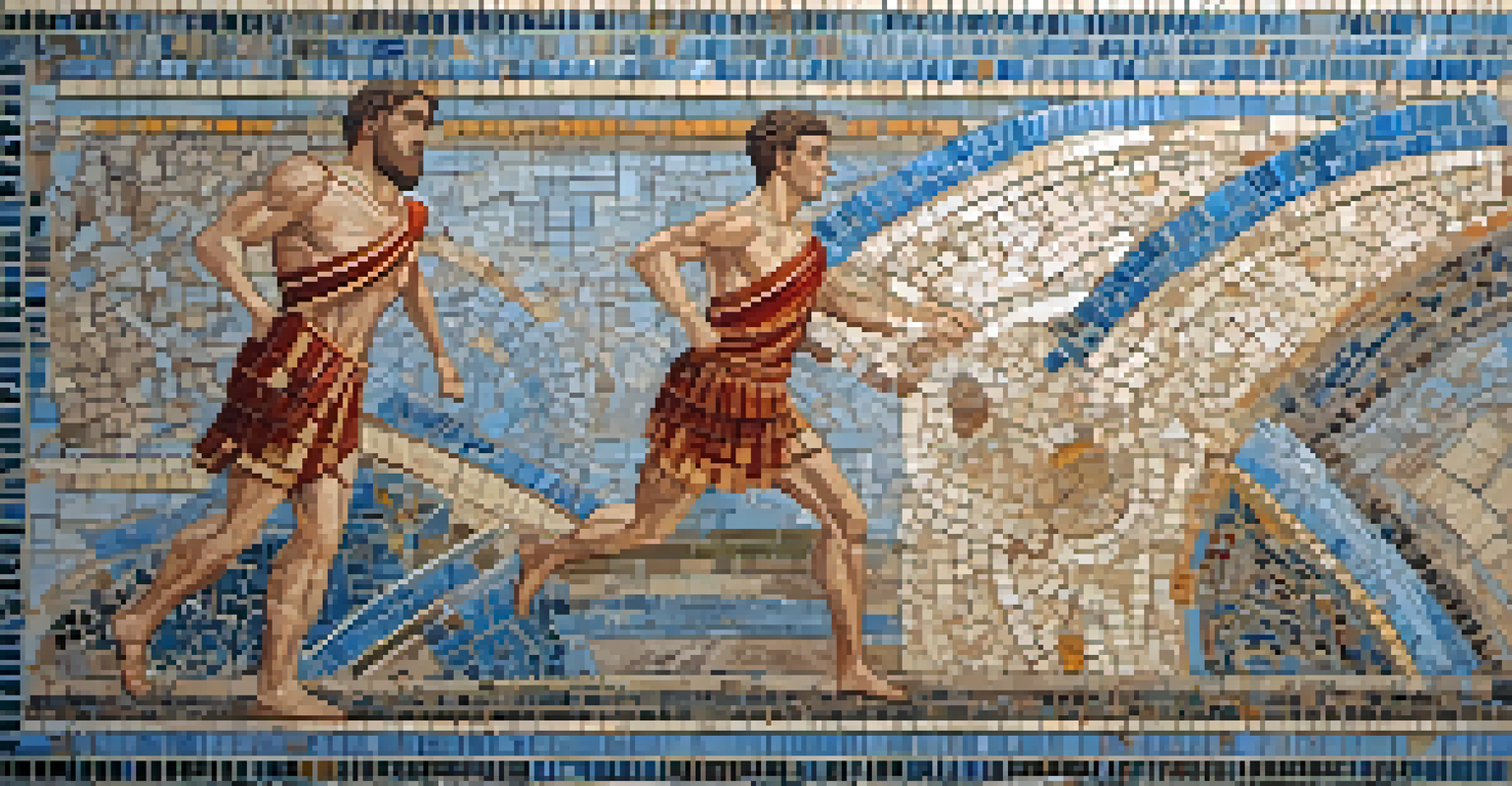The Body in Ancient Roman Art: Power and Ideals

The Significance of the Human Body in Roman Culture
In Ancient Rome, the human body was more than just a physical form; it was a canvas for expressing power, beauty, and societal ideals. The Romans believed that the body reflected one's character and status, leading to an emphasis on physical perfection. This cultural preoccupation is evident in their art, where the depiction of the human figure often conveyed messages about strength, virtue, and even moral integrity.
The body is a sacred garment.
For instance, sculptures of emperors and gods were meticulously crafted to showcase idealized features, symbolizing not just beauty but also authority and divinity. The attention to detail in these works highlights the Romans' belief in the connection between the body and the soul, suggesting that a well-formed body could lead to a well-formed character. This idealization of the body became a powerful tool for propaganda, reinforcing the social hierarchy.
Moreover, the human figure was central to various artistic forms, including sculptures, frescoes, and mosaics. This focus on the body in art contributed to a shared cultural identity, emphasizing the values that Romans held dear, such as strength, resilience, and beauty. By exploring these representations, we can gain insights into the ways the Romans viewed themselves and their society.
Idealized Bodies: Beauty and Morality in Roman Art
The concept of ideal beauty in Ancient Rome was deeply intertwined with moral values. Artists often sculpted figures with harmonious proportions, signifying not only physical beauty but also inner virtue. This relationship between exterior appearance and moral character suggests that the Romans held a belief that beauty was a reflection of moral goodness.

Take, for example, the famous statue of Venus, the goddess of love and beauty, which encapsulates the Roman idea of an ideal body. Her form, characterized by soft curves and balanced proportions, was not merely about aesthetics; it represented the very ideals of love, femininity, and virtue that Romans aspired to. Thus, art became a means of reinforcing cultural norms surrounding morality and beauty.
Body as a Reflection of Society
In Ancient Rome, the human body was a canvas expressing societal ideals, power, and moral character.
Additionally, the portrayal of athletes and heroic figures in art often emphasized muscularity and physical prowess. These depictions were a celebration of not just the human form but also the virtues of courage and strength in battle, qualities highly esteemed in Roman society. In this way, the idealized body served as a symbol for both personal and societal ideals.
Political Power and the Representation of the Body
In Ancient Rome, political power was intricately linked to the human body, especially in the representation of leaders through art. Emperors were often depicted in a larger-than-life manner to signify their divine right to rule. This portrayal was not only about showcasing their physical attributes but also about projecting an image of invincibility and authority.
Art is the most beautiful of all lies.
For example, the famous statue of Augustus of Primaporta exemplifies this connection between the body and power. Augustus is shown in a pose reminiscent of classical Greek orators, idealizing his form while simultaneously reinforcing his status as a leader. Through this art, the emperor's physicality became synonymous with the strength of the Roman Empire itself, creating a lasting legacy.
Moreover, the use of portraiture in Roman art served as a tool for political propaganda. By emphasizing certain physical traits, such as a strong jawline or a commanding stance, artists crafted an image of the emperor that resonated with the ideals of power and leadership. This deliberate representation allowed the ruling class to maintain control over public perception and reinforce their authority.
The Role of Gender in Roman Artistic Representations
Gender played a significant role in how bodies were represented in Roman art. Male figures were often depicted as muscular and heroic, embodying strength and valor, while female figures were usually idealized for their beauty and grace. This dichotomy reflects the societal norms and expectations surrounding masculinity and femininity in Ancient Rome.
For instance, sculptures of male gods like Mars or Hercules showcase their robust physiques, symbolizing their roles as protectors and warriors. In contrast, representations of female figures tended to focus on elegance and beauty, such as in the depictions of Venus and Juno. This not only highlights the different ideals associated with each gender but also reveals how power dynamics influenced artistic expression.
Art and Political Power Connection
Roman art intricately linked physical representation of leaders to their political authority and divine right to rule.
Additionally, the portrayal of women in art often served to reinforce their roles within the family and society. While male figures were celebrated as heroes, women were depicted in nurturing roles, emphasizing their importance in domestic life. This artistic distinction underscores the complex interplay between gender, power, and societal ideals in Ancient Rome.
Physique and Social Status: Class Reflections in Art
The way bodies were depicted in Roman art also reflected social status, with the elite often portrayed in a more idealized manner than the lower classes. This distinction served to reinforce societal hierarchies, as the physical appearance of the upper class was often associated with moral superiority and virtue. Therefore, art became a medium for expressing and solidifying class divisions.
For example, portraits of wealthy citizens frequently highlighted refined features and sophisticated attire, emphasizing their elevated status. In contrast, representations of lower-class individuals tended to be more realistic, focusing on the hardships of daily life. This disparity in artistic representation not only illustrates the differences in social standing but also offers insight into the values of Roman society.
Moreover, the idealized bodies of the elite served as aspirational figures for the lower classes, perpetuating the belief that social mobility could be achieved through physical and moral improvement. This interplay between art, body image, and class dynamics underscores the powerful role that artistic representation played in shaping societal attitudes.
The Influence of Greek Art on Roman Body Representation
Ancient Roman art was heavily influenced by Greek ideals, particularly in the representation of the human body. The Romans admired Greek culture and sought to emulate its artistic achievements, leading to a blending of styles and ideals. This influence is particularly evident in the way the human form was idealized and celebrated in both cultures.
For instance, Greek sculptures often depicted the human body in a state of perfect balance and proportion, a principle that the Romans adopted in their own works. The famous statue of Discobolus, the Discus Thrower, exemplifies this idealized representation of the human form, which the Romans sought to replicate in their own art. By doing so, they not only honored Greek traditions but also reinforced their own cultural values.
Gender Roles in Artistic Depiction
Artistic representations in Rome highlighted distinct gender norms, showcasing muscularity in men and beauty in women.
Additionally, the Romans adapted Greek techniques in sculpture and architecture, which allowed them to create more lifelike representations of the human body. This melding of Greek and Roman ideals resulted in a rich artistic tradition that celebrated the beauty of the human form, influencing future generations of artists and sculptors throughout history.
Legacy of Roman Body Art: Influence on Future Generations
The legacy of Ancient Roman body art continues to resonate through the ages, influencing countless artistic movements and styles. The ideals of beauty and power established by the Romans laid the groundwork for Renaissance art, where the human form was once again celebrated and idealized. Artists like Michelangelo and Raphael drew inspiration from Roman sculptures and frescoes, reinterpreting these themes in their own works.
Moreover, the focus on anatomical accuracy and proportion in Roman art paved the way for advancements in the study of human anatomy. The detailed observations made by Roman artists contributed to a greater understanding of the human body, which became essential for artists in later periods. This emphasis on realism and the idealized body has shaped the way we view art even today.

In essence, the impact of Roman body art extends beyond its own time, influencing not only the art world but also cultural perceptions of beauty and power. By examining these artistic representations, we gain a deeper appreciation for how the body has been used as a symbol of societal ideals throughout history.